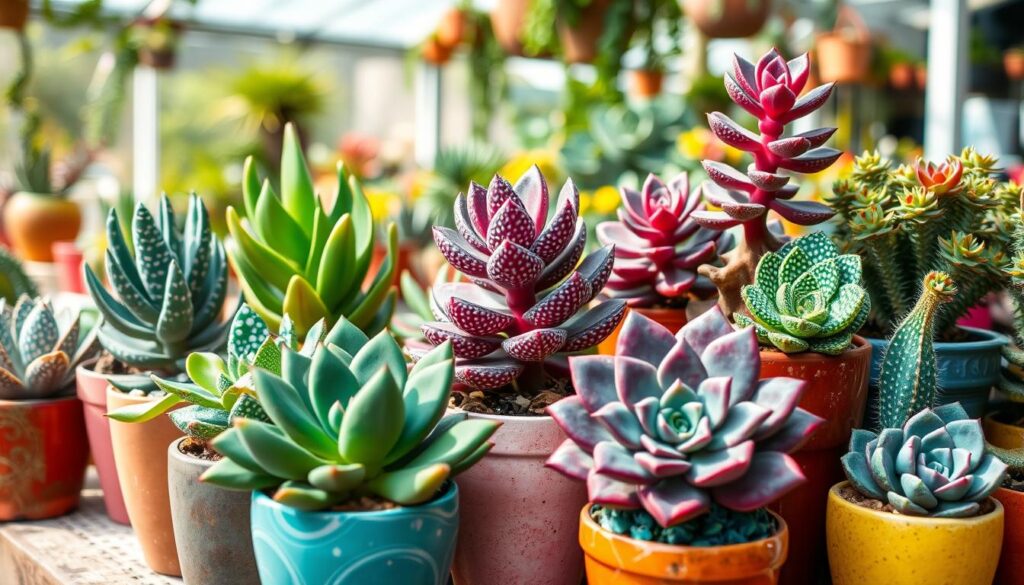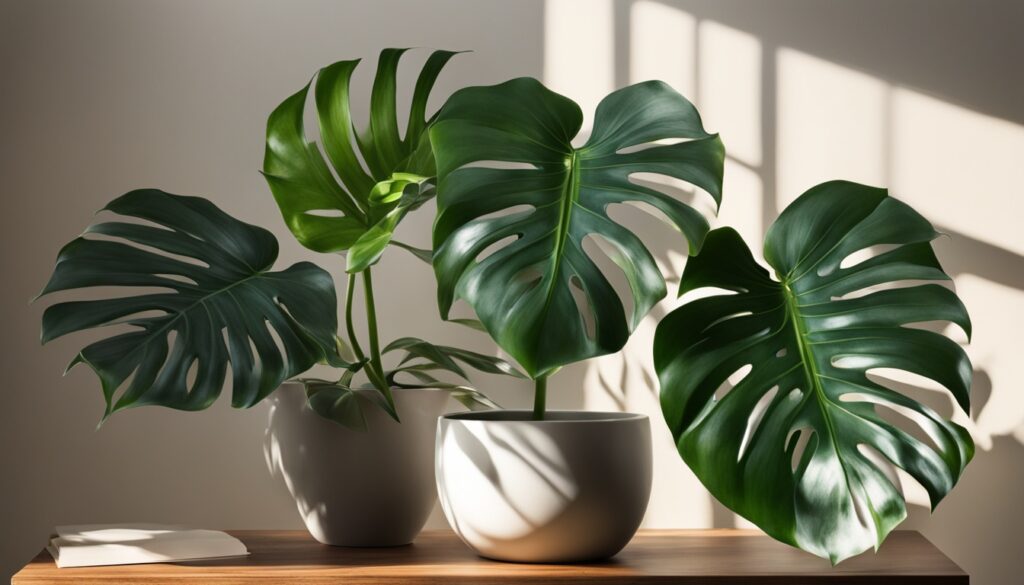Ever wondered about succulents beyond the usual ones? Rare exotic succulents are a world of unique, stunning plants. They come from all over, showing off amazing forms, colors, and textures. These plants are not just beautiful; they also show us what plants can really be.
Lithops look like stones, while Kalanchoe ‘Pink Butterflies’ have bright, colorful leaves. These plants have adapted to survive in tough conditions. They are true wonders of nature. Collectors love them for their beauty and the challenge of caring for them. Rare succulents are the ultimate goal for plant lovers, pushing them to grow their skills.
Key Takeaways
- Rare exotic succulents exhibit diverse and unique forms, often resembling non-plant objects.
- These drought-tolerant plants have evolved worldwide and are sought-after by collectors.
- Popular rare succulent varieties include Lithops, Variegated String of Hearts, and Kalanchoe ‘Pink Butterflies’.
- Cultivating rare succulents can be challenging, requiring specific care instructions.
- Collectors value these exceptional specimens for their aesthetic appeal and the thrill of preservation.
Understanding Rare Exotic Succulents and Their Appeal
Rare and exotic succulents have won the hearts of many plant lovers around the world. These xerophytic species thrive in dry places, offering a wide range of shapes and colors.
Defining Exotic Succulents
Exotic succulents are unusual cacti and plants from harsh environments. They are found in deserts, rocky areas, and tropical places. Their unique looks and colors make them very popular among collectors.
Why Collectors Seek Rare Varieties
Collectors love rare succulents for their hard-to-grow nature and special traits. They seek these plants for their rarity, cultural value, and the excitement of growing them. Places like nurseries, gardens, online stores, and plant shows are where you can find these plants.
The Evolution of Succulent Collection
The hobby of collecting succulents has grown a lot. Enthusiasts now use new ways to grow and care for these plants. They use techniques like tissue culture and selective breeding to grow their collections. This helps in preserving these amazing xerophytic species.
“Rare succulents offer anecdotes of survival, resilience, and adaptability, contributing to a deeper bond with nature.”
Essential Care Requirements for Exotic Succulents
Caring for rare and exotic ornamental succulents needs a careful balance of conditions. These tropical succulents and desert botanicals grow best in specific light, soil, and water. This is because they thrive in their natural habitats.
First, these plants need bright, indirect sunlight. It’s important to slowly get them used to more light to avoid sunburn. They do well in temperatures between 60°F and 80°F (15°C to 27°C) during the day. Cold temperatures can harm them.
It’s crucial to use well-draining soil for these succulents. A mix of potting soil, coarse sand, perlite, or pumice works well. This mix helps water drain fast, preventing root rot.
- Water succulents only when the soil is dry. They can handle drought well.
- Use a balanced, water-soluble fertilizer at a quarter strength. This helps them grow and look their best in spring and summer.
Pests like mealybugs, spider mites, and aphids can harm these plants. To fight pests, isolate affected plants and remove pests gently. Use neem oil or insecticidal soap if needed. Keeping a close eye on your plants and providing the right conditions helps prevent problems.
By following these care tips, you can keep your rare and exotic succulents healthy and beautiful for a long time.
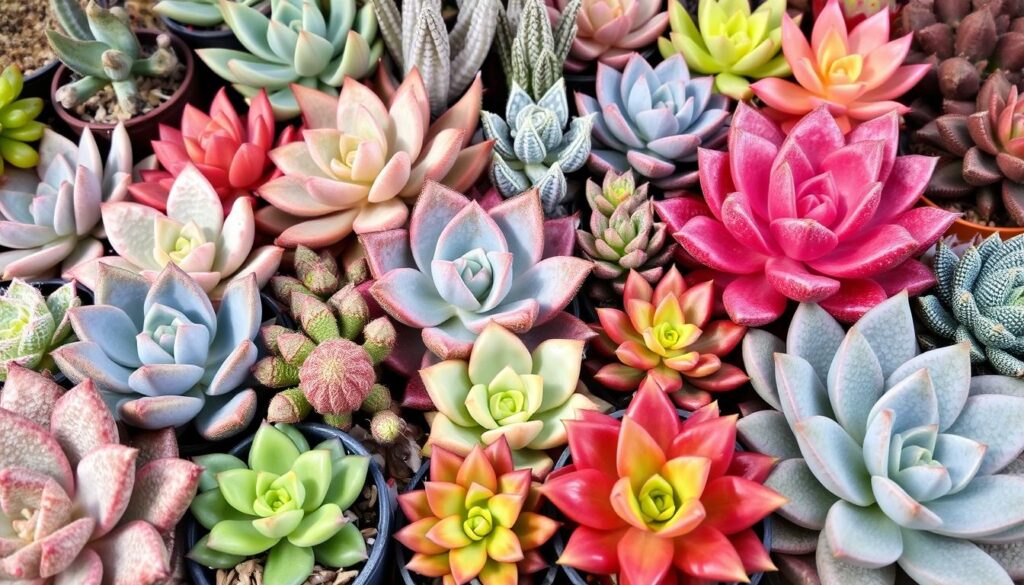
Popular Rare Succulent Families and Genera
The world of rare exotic succulents is full of amazing plant families and genera. You’ll find everything from the striking Aizoaceae to the mesmerizing Astrophytum and the unique Crassulaceae. These hardy succulents have won the hearts of many collectors and plant lovers.
Aizoaceae Family Specimens
The Aizoaceae family is famous for its Lithops varieties. These plants look like pebbles and are known as “living stones.” They grow low and are very tough, doing well in full sun and growing up to 8 inches.
Rare Astrophytum Varieties
Astrophytum is another popular genus with rare plants like the Astrophytum myriostigma and Astrophytum ornatum hybrids. These succulents can grow from 1 inch to 8 feet tall. They need full sun to grow their best.
Unique Crassulaceae Species
The Crassulaceae family has many rare succulents, including the stunning Lenophyllum guttatum variegated. These plants come in all sizes, from tiny 1-inch plants to huge 3-foot ones. Each has its own special look that attracts collectors.
| Succulent Variety | Size Range | Light Requirements | Watering Needs |
|---|---|---|---|
| Aizoaceae (Lithops) | 3-8 inches | Full sun | Water when top 1-2 inches of soil are dry |
| Astrophytum myriostigma | 1 inch to 8 feet | Full sun | Water when top 1-2 inches of soil are dry |
| Lenophyllum guttatum variegated | 1 inch to 3 feet | Full sun to partial sun | Water when top 1-2 inches of soil are dry |
These rare succulent varieties give us a peek into the exciting world of hardy succulents. From the tiny Lithops to the tall Astrophytum and the special Crassulaceae, each plant is a treasure for rare exotic succulent fans.
Light Requirements and Optimal Growing Conditions
Rare exotic drought-tolerant plants and xerophytic species need the right light. They should get used to more sunlight slowly over 1-2 weeks. This helps keep their colors bright and their growth tight.
For these plants, sunny windowsills, grow lights, and some outdoor sun work well. With the right light, they show off their beauty. Their leaves shine like jewels, and their shapes are truly unique.
| Succulent Species | Seed Pricing | Seed Coverage |
|---|---|---|
| Sedum Stoloniferum | $12.95 | 1,000 seeds, 20 sq. ft. |
| Blue Spruce Sedum | $24.95 | 2,500 seeds, 50 sq. ft. |
| Queen Agave | $2.95 | 5 seeds |
| White Stonecrop | $10.95 | 44mg pack (about 2,000 seeds) |
| Yellow Stonecrop | $14.95 | 1,000 seeds, 20 sq. ft. |
| Czars Gold Sedum | $9.95 | 15mg pack (about 1,000 seeds) |
| Summer Glory Sedum | $18.95 | 1,000 seeds, 20 sq. ft. |
| Turkish Delight Multi-seed Pellets (Sedum ussueiense) | $4.95 | 28mg pack (about 25 multi-pelleted seeds) |
Succulents come in many shapes and sizes. They range from soft, feather-like Echeveria to the stark Lithops. Many are threatened by overcollection and habitat loss. This makes it important to protect them and grow them responsibly.
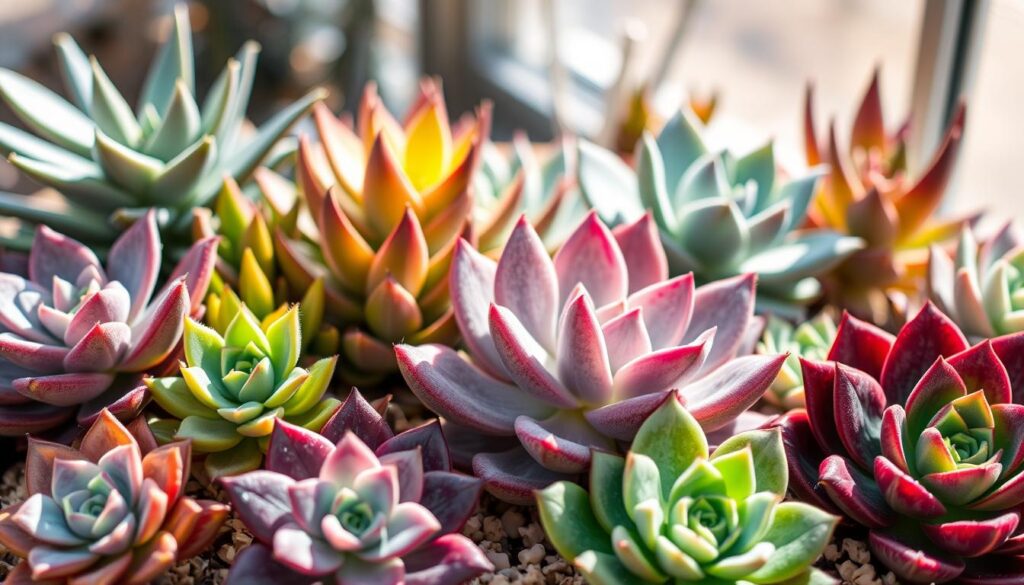
“Rare succulents are often preferred for their uniqueness, with some featuring leaves that shimmer like jewels or boasting geometric shapes; this unique appeal draws collectors and enthusiasts to these plants.”
Soil and Drainage Considerations for Rare Species
When growing unusual cacti, ornamental succulents, and tropical succulents, soil and drainage are key. These plants need special soil that matches their natural homes. This ensures they get the right nutrients and air.
Specialized Soil Mixtures
Many rare succulents, like mesembs and caudiciforms, need a gritty, draining soil to avoid root rot. The Bonsai Jack Gritty Mix is a great choice. It has the right mix of materials to mimic their rocky, dry environments.
Container Selection Tips
Picking the right container is vital for rare succulents. Look for pots with lots of drainage holes to let water out. Also, choose shallow but wide pots. This lets the roots spread and grow strong.
Drainage Solutions
- Put a layer of coarse gravel or pebbles at the bottom for better drainage and air.
- Use a potting mix made for unusual cacti, ornamental succulents, or tropical succulents. These mixes balance moisture and drainage well.
- Try placing the container on feet or use a drainage tray. This helps water flow away from the roots.
By thinking about the soil and drainage needs of rare succulents, you can create a great place for them to grow. This will help these tropical succulents thrive and look beautiful in your collection.
Watering Techniques for Exotic Varieties
Caring for rare and exotic succulents means getting the watering right. These desert botanicals and hardy succulents need just the right amount of moisture. Water them deeply but not too often, when the soil is dry and the leaves are flexible.
Make sure water drains out of the pot’s hole. This prevents root rot, a big problem for rare exotic succulents. Adjust your watering based on the plant’s needs, especially in colder months.
| Watering Myth | Fact |
|---|---|
| Succulents enjoy a good watering, the more the better. | Succulents like a good soak followed by a drying period to mimic their natural sporadic rain cycle. |
| Watering succulents little by little is better for the roots. | Deep watering is recommended to encourage strong and healthy root growth. |
| Succulents need more water in the heat. | Overwatering during hot months can lead to root rot and other moisture-related problems. |
By using these watering techniques, your succulents will thrive. They’ll add a desert touch to your home.
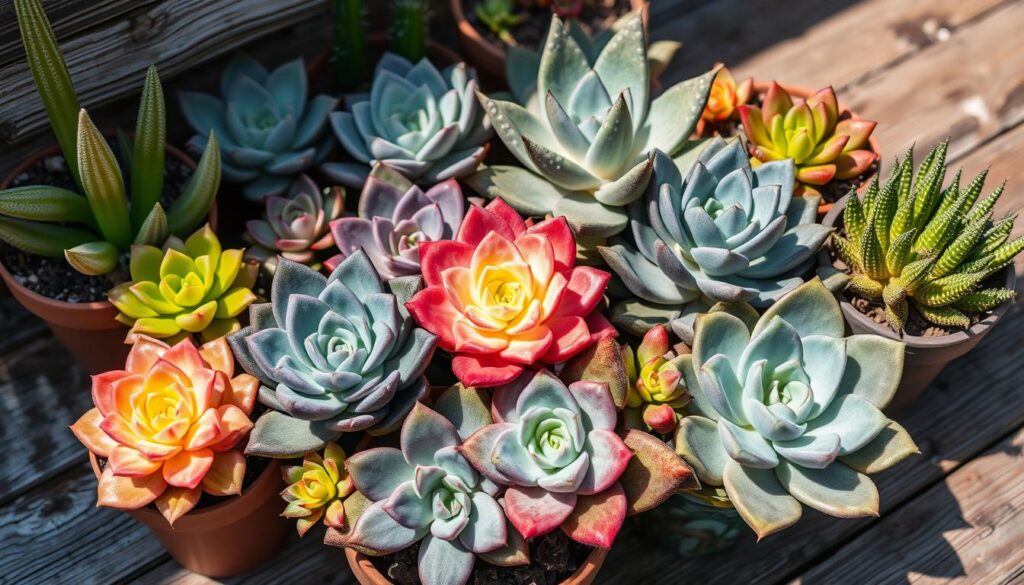
“Watering succulents is an art, not a science. It takes patience and a keen eye to get it just right.”
Most Sought-After Lithops Varieties
The Lithops species are among the most fascinating succulent varieties for collectors. The Lithops salicola ‘Bacchus’ and the Lithops optica Rubra are two of the most sought-after.
Lithops salicola ‘Bacchus’
The Lithops salicola ‘Bacchus’ is a standout xerophytic species. It has striking blue-green hues and unique grooves. This drought-tolerant plant is priced at €11.00, making it a prized addition to any succulent collection.
Lithops optica Rubra
The Lithops optica Rubra is equally captivating. It has a deep, reddish-brown color that makes it stand out. Priced at €15.00, this rare Aizoaceae family specimen is a must-have for those looking to enhance their succulent collection.
These Lithops varieties are a testament to the beauty of rare and exotic succulents. They captivate collectors with their unique looks and specific care needs.
| Variety | Price |
|---|---|
| Lithops salicola ‘Bacchus’ | €11.00 |
| Lithops optica Rubra | €15.00 |
“These exceptional Lithops varieties exemplify the allure of rare and exotic succulents, captivating collectors with their unique appearances and specialized care requirements.”
Rare Variegated Succulent Specimens
For serious succulent collectors, rare variegated specimens are the ultimate treasure. These plants dazzle with their unique patterns and bright colors. They are the crown jewels of any succulent collection.
The Astrophytum myriostigma nudum variegato, or variegated star cactus, is a standout. Its leaves are a mix of green, white, and yellow. This makes it a favorite among succulent lovers.
The Sulcorebutia rauschii variegata is another gem. It has green and creamy-white segments. This combination is a feast for the eyes and a must-have for collectors.
The Lenophyllum guttatum variegated is also highly sought after. It displays a range of colors like green, pink, and white. This makes it a vibrant addition to any succulent collection.
These rare succulents are true works of art. They captivate plant enthusiasts and collectors. Their beauty and rarity make them highly valued in the succulent world.
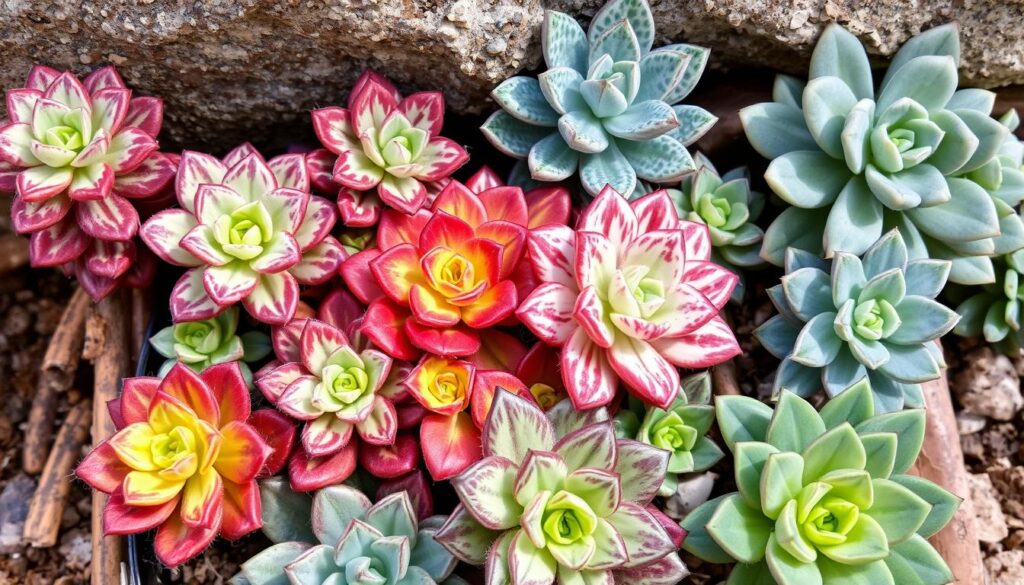
Specialized Propagation Methods
In the world of rare and exotic succulents, special ways to grow them are key. Growers use advanced methods like tissue culture and selective breeding. These help keep these tropical succulents, desert botanicals, and hardy succulents available for all to enjoy.
Tissue Culture Techniques
Tissue culture is a lab method that helps grow rare succulents. It involves growing tiny plant parts in a controlled setting. This way, many identical plants can be made quickly, helping to save rare varieties.
This method is crucial for keeping the genetic variety of desert botanicals alive. It overcomes the usual challenges of growing plants.
Selective Breeding Approaches
For those who collect rare succulents, selective breeding is essential. It involves choosing parents with special traits to create new plants. This can lead to unique tropical succulents and hardy succulents.
This careful process can take many generations. It results in plants that are truly one-of-a-kind. These plants are loved by succulent fans all over the world.
Thanks to these advanced growing techniques, the world of succulents is always growing. It offers a wide range of desert botanicals for everyone to discover and cherish.
Seasonal Care and Dormancy Periods
The world of rare exotic succulents is fascinating. It’s filled with unique plants that love different environments. Knowing when they need to rest is key to their care.
Some succulents, like Aloe and Sedum, slow down in the summer. They do this to survive the heat and dryness. In the winter, others, like Echeveria and Haworthia, hide from the cold.
It’s important to adjust how you care for your succulents during these times. Water them less, maybe once every 4-6 weeks. This helps prevent root rot. Also, give them 4-6 hours of indirect sunlight a day.
Temperature matters too. Keep them between 50-60°F (10-15°C) in the winter. Use soil mixes made for succulents to keep them healthy.
When succulents are dormant, they might look different. Their leaves and stems may get waxier or dustier. Growth might slow down, and colors could change. Roots might even stop growing.
By understanding and respecting these dormancy cycles, you can help your succulents thrive. With the right care, they can be the stars of your collection.
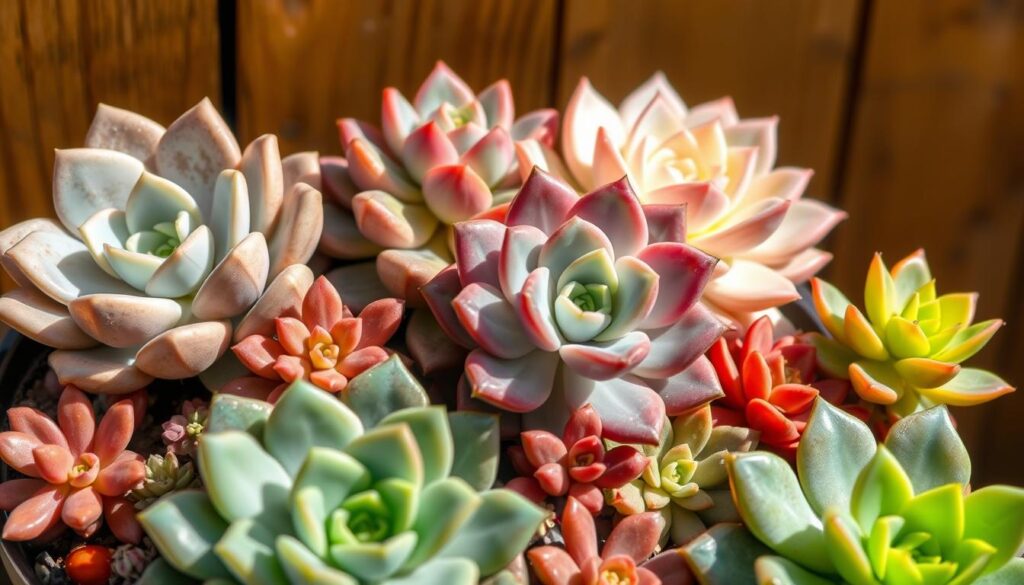
Premium Astrophytum Cultivars
The world of rare exotic succulents is fascinating, especially the premium Astrophytum cultivars. These plants thrive in dry environments and are loved by collectors. They are known for their unique shapes and patterns.
Astrophytum myriostigma Varieties
The Astrophytum myriostigma fukuryu is a favorite for its star-like patterns. The Astrophytum myriostigma variegato is also popular for its beautiful variegated leaves. These plants are true treasures for succulent lovers.
Astrophytum ornatum Hybrids
The Astrophytum ornatum hybrids, like the Astrophytum ornatum ‘Fujiyama’, are stunning. They have a symmetrical arrangement of tubercles. These plants are eye-catching and loved by collectors.
| Astrophytum Cultivar | Price |
|---|---|
| Astrophytum Myriostigma Koh-yo | ₹999 |
| Astrophytum Myriostigma Koh-yo Variegated | ₹950 |
| Astrophytum Myriostigma Nudum Variegated | ₹750 |
| Astrophytum Myriostigma Variegated-VM00A | ₹599 |
| Astrophytum Myriostigma Variegated-VM00I | ₹550 |
These premium Astrophytum cultivars are true treasures for succulent collectors. They add a unique and captivating touch to any collection.
Collecting and Building Your Rare Succulent Collection
Starting a rare succulent collection takes research, patience, and careful care. Whether you love ornamental, tropical, or desert succulents, growing a unique collection is both rewarding and exciting. Begin with easy-to-grow plants like the Monstera Adansonii or the Philodendron Brasil. These plants are great for beginners because they’re easy to care for.
As you grow your collection, learn about each succulent’s needs. This includes light, soil, and water. For example, big-leafed plants like Monstera Thai Constellation need more room. Keep humidity at 60-80% and temperatures between 65°F and 80°F for best growth.
Buy your succulents from reliable sources like nurseries or online stores. This ensures you get healthy plants that fit your home. Check your plants often, remove bad leaves, and fertilize every 4-6 weeks to meet their needs.
